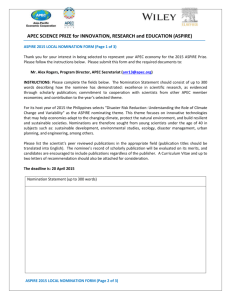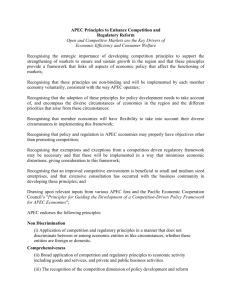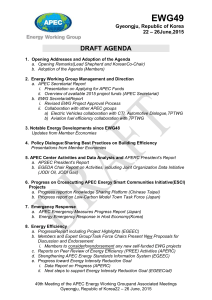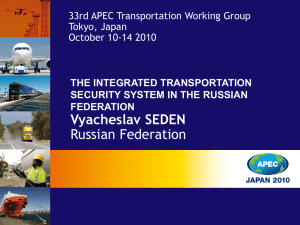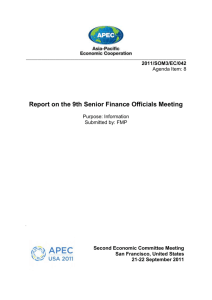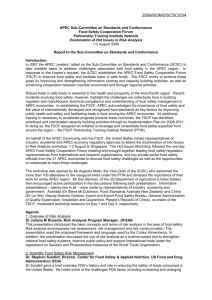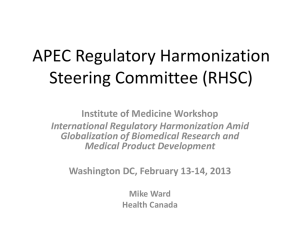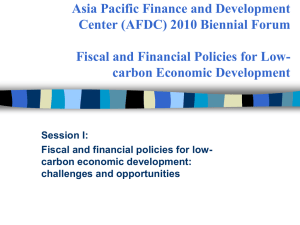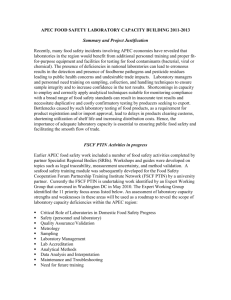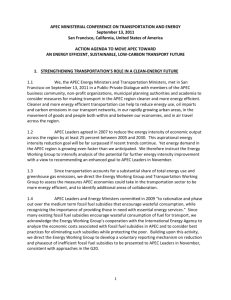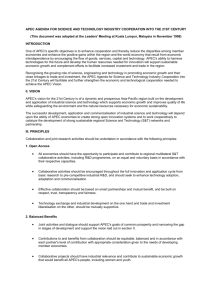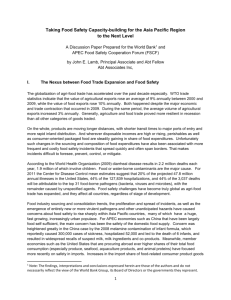word - Food Standards Australia New Zealand
advertisement
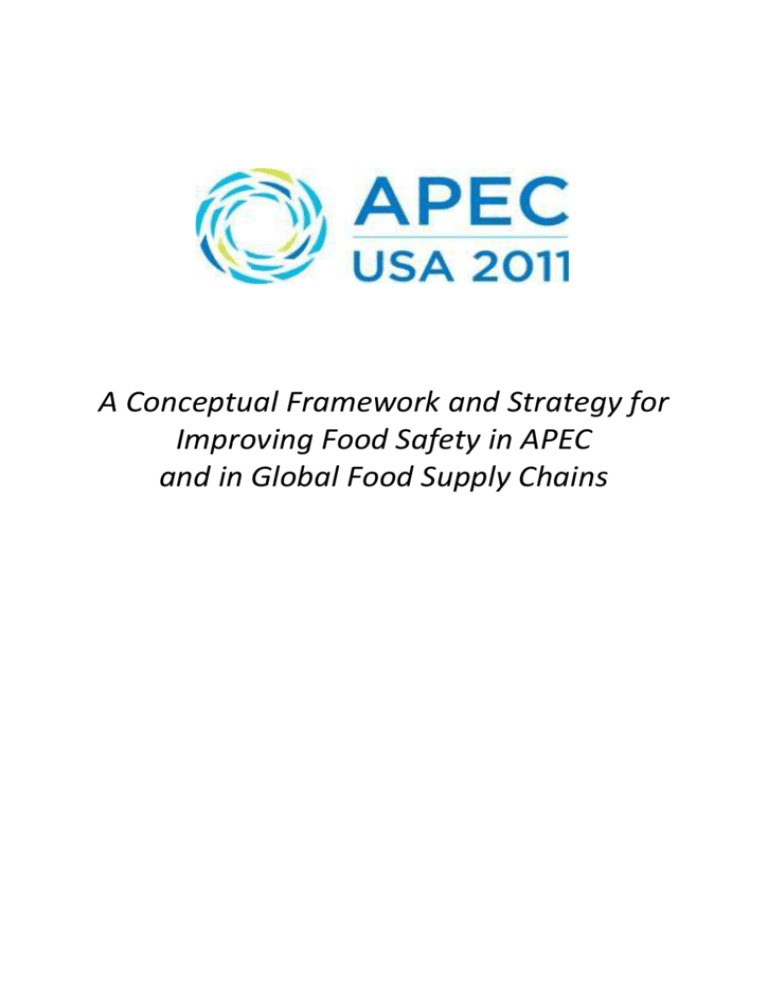
A Conceptual Framework and Strategy for Improving Food Safety in APEC and in Global Food Supply Chains A Conceptual Framework and Strategy for Improving Food Safety in APEC and in Global Food Supply Chains Public Health Impact: Up to one-third of the population of developed countries is affected by food borne illness each year and the problem is even more wide spread in developing countries1. The World Health Assembly Declaration of 20102 has confirmed that food borne disease continues to represent a serious threat to the health of millions of people in the world, particularly those in developing countries with poor nutritional status. Economic Impact: The economic impact of food safety incidents can also be severe3, affecting both the private sector and governments. Governments face macroeconomic effects, including losses due to productivity, declines in trade and increases in health costs. Small and medium enterprises in the agri-business sector are disproportionately affected by post-harvest losses, loss of domestic and export markets, absenteeism and loss of productivity. Food Safety: A Priority for Improving Public Health and Economic Growth 1. Food supply chains are increasingly global in nature, with ingredients grown in one country, processed and/or prepared in a second or third country and distributed and consumed in yet another country or region of the world. As a result, new food safety challenges have emerged and food safety has increased significantly in importance to global public health and economic growth and development4. The APEC region is home to the world’s largest agricultural and fisheries producers with total agricultural exports of $403 billion in 20095. As such, the safety and quality of food grown, transported, processed and distributed by APEC member economies is critical to assuring the quality and safety of food in global supply chains. 2. Due to the significant economic and public health impacts of food safety incidents, as well as the need to ensure that the region’s small-scale farmers, manufacturers and others can compete in global export markets, a coordinated, regional approach to improving food safety is necessary. Assuring the safety and quality of food in supply chains requires a framework and strategy built on significant and effective cooperation with producers, processors, and distributors; food safety regulators; and the academic community of food safety scientists. If properly targeted at the individual, organisational and at the national level, building the food safety capacity of countries to produce, access and export, and to distribute safe food to their 1 WHO Global Strategy for Food Safety, World Health Organization, 2002 2 63rd World Health Assembly, Advancing Food Safety Initiatives, 20 May 2010 3 Examples from the APEC region include: loss of sales associated with spinach contamination in the US in 2006 was estimated at $1 million/day. Mexico suffered export market losses in 2008 after findings of contaminated tomatoes/ peppers prevented Mexico from exporting these products to the US. 4 This is particularly the case in recent years following a series of global events associated with incidences of contamination (dioxin, melamine,) and outbreaks of pathogens such Escherichia coli O157:H7 and Bovine Spongiform Encephalopathy (mad cow disease). 5 Source: UN Commodity Trade Statistics; Chinese Taipei- Ministry of Finance citizens can contribute significantly both to improved public health outcomes and trade opportunities. 3. In 2007, the establishment of the APEC Food Safety Cooperation Forum (FSCF) was welcomed, with the 21 APEC Economic Leaders recognising food safety as a critical priority and issuing a collective mandate for APEC to improve food safety standards and practices. The APEC FSCF, co-chaired by Australia and China, is dedicated to: i. Developing transparent information-sharing and communication networks that provide accurate and timely information to consumers and producers on food safety; ii. Working towards establishing domestic food safety regulatory systems, including food inspection/assurance and certification systems that: a. harmonize with international standards (such as Codex, OIE, IPPC); b. are consistent with members’ rights and obligations under the Sanitary and Phytosanitary Measures (SPS) and the Technical Barriers to Trade (TBT) Agreements of the World Trade Organization; and iii. Enhancing skills and human resource capacities to enable the development of national food safety regulatory systems that are harmonized with international standards. The APEC FSCF has developed a comprehensive food safety framework and strategy reflecting key elements of the WHO /FAO Food Control System6 which encompasses the entire food safety control system. This promotes a coordinated approach to ensure (1) improved public health; (2) increased trade facilitation, including small and medium enterprise participation in food supply chains; (3) promotion of regulatory cooperation, consistent with internationally agreed standards and systems; (4) increased economic development; and (5) cooperation across all food safety stakeholders to assure sustainable food safety outcomes (see Figure 1 and Attachment 1). The FSCF work also carries the potential to make a significant contribution to the related APEC goal to increase food security in the region. 4. In 2008, the FSCF Partnership Training Institute Network (PTIN) was established to include industry and academia perspectives and provide a tri-partite foundation for food safety capacity building. The FSCF PTIN, in cooperation with donor organizations, will develop sustainable training modules that can be used throughout the region as well as a network of food safety experts. In May 2010, in cooperation with the World Bank Group, the FSCF PTIN Expert Working Group meeting produced a road map for improving the accessibility and content of food safety training in the APEC region. It was recognised that there is a diverse range of training materials available, but in general, food safety capacity building is under-resourced in the region, and accessibility of training materials is limited, particularly for small and mediumsized enterprises not currently participating in global supply chains. The FSCF PTIN developed a website (http://fscf-ptin.apec.org) to broaden the accessibility and use of training materials based on international standards and best practices. 5. 6 APEC recognizes that elements of the comprehensive strategy could serve as a model for other regions of the world. The APEC region is culturally and ethnically diverse and the level of development of the APEC member economies spans a wide and representative range. APEC member economies serve world food supply chains. APEC has thus partnered with international Food & Agriculture Organisation of the United Nations & the World Health Organisation. Assuring Food Safety and Quality: Guidelines for Strengthening National Food Control Systems. Joint FAO/WHO Publication. donor organizations and institutions such as the World Bank, the World Health Organisation and the Food and Agriculture Organisation, to assist with addressing key capacity building elements of the strategy on a sustainable basis. Key outcomes: Raised the profile of food safety both within member economies and across the region; Significantly improved information sharing and communication networks, through the establishment of the FSCF Secretariat as well as the FSCF meetings and FSCF workshops; The establishment of the FSCF Partnership Training Institute Network (PTIN) to provide a coordinated and sustainable vehicle for food safety capacity building in the region; and Implemented a range of FSCF and its PTIN capacity building activities7 that addressed key food safety capacity building priorities in the region. Next steps: Moving forward, future actions will be undertaken in a coordinated way, including targeting food safety capacity building needs through regulatory cooperation and collaboration with stakeholders at the regional, national, organisational and individual levels. This includes: 7 Continuing to improve information sharing and communication networks Advancing regulatory cooperation among member economies using best practice methods for establishing food safety control systems in APEC member economies Developing accessible, sustainable, scalable, and replicable training focused on priority capacity building needs Building partnerships with the World Bank and other intergovernmental and regional organizations Promoting the APEC model for implementation in other regions Developing a forward action plan for 2011-2014 Food laws, standards and enforcement systems; risk analysis; microbiological risk assessment; risk communication; developing food safety plans for the supply chain;, management of food safety incidents and food recalls; common use of export certificates. Figure 1 Sustainable Food Safety Outcomes Improved Public Health Regulatory Cooperation Trade Facilitation with SME input across Supply Chain Services Increased Economic Development Economy-wide Food Safety Control Systems Food Safety Laws, Regulations and Standards Food Safety Control Management Inspection Services Laboratories- Food Monitoring and Epidemiological Data Information Communication Education Training APEC Food Safety Cooperation Forum Develop transparent information sharing and communication networks Enhance skills and human resource capacities to enable development of food safety standards and systems consistent with those agreed internationally Harmonize food safety standards to the extent possible with international standards and encourage food safety systems consistent with WTO SPS & TBT Agreements APEC Food Safety Cooperation Forum Partnership Training Institute Network Regulators/Industry/Academia Supporting the development and implementation of sustainable food safety capacity building activities that support the use of international standards and best practices Attachment 1 Economy-wide Food Safety Control Systems A schematic model of the economy-wide food control system and how needs within the system can be addressed via the FSCF and its PTIN can be seen in Figure 1. Food Laws and Regulations This component of the Food Control System model consists of the development of relevant and enforceable food laws, regulations and food standards. The development of relevant and enforceable food laws, standards and regulations, are essential components of a modern food control system. Food Safety Control Management Effective food safety control systems require policy and operational coordination at the national level, as well as concerted efforts by all relevant stakeholders. While the detail of such functions will be determined by the national legislation, they would include the establishment of a leadership function and administrative structures with clearly defined accountability for issues such as: the development and implementation of an integrated national food control strategy; operation of a national food control programme; securing funds and allocating resources; setting standards and regulations; participation in international food control related activities; developing emergency response procedures; and carrying out risk analysis. Inspection Services The administration and implementation of food laws require a qualified, trained, and efficient food inspection service. The food inspector is the key functionary who has day-to-day contact with the food industry, trade and often the public. The reputation and integrity of the food control system depends, to a very large extent, on their integrity and skill. Laboratory Services: Food Monitoring and Epidemiological Data Laboratories are an essential component of a food control system. All food analysis laboratories may not be under the control of one agency or ministry, and a number could be under the jurisdiction of the states, provinces and local authorities. The Food Control Management should, however, lay down the norms for food control laboratories and monitor their performance and at a minimum, laboratories should have adequate facilities for physical, microbiological and chemical analyses. It is not only the type of equipment that determines the accuracy and reliability of analytical results but also the qualification and skill of the analyst and the reliability of the method used. Information, Education, Communication and Training An increasingly important role for food control systems is delivery of information, education and advice to stakeholders across the farm-to-table continuum. These activities include the provision of balanced factual information to consumers; information packages and educational programmes for key officials and workers in the food industry; development of train-the-trainer programmes; and reference literature to workers in the agriculture and health sectors.
